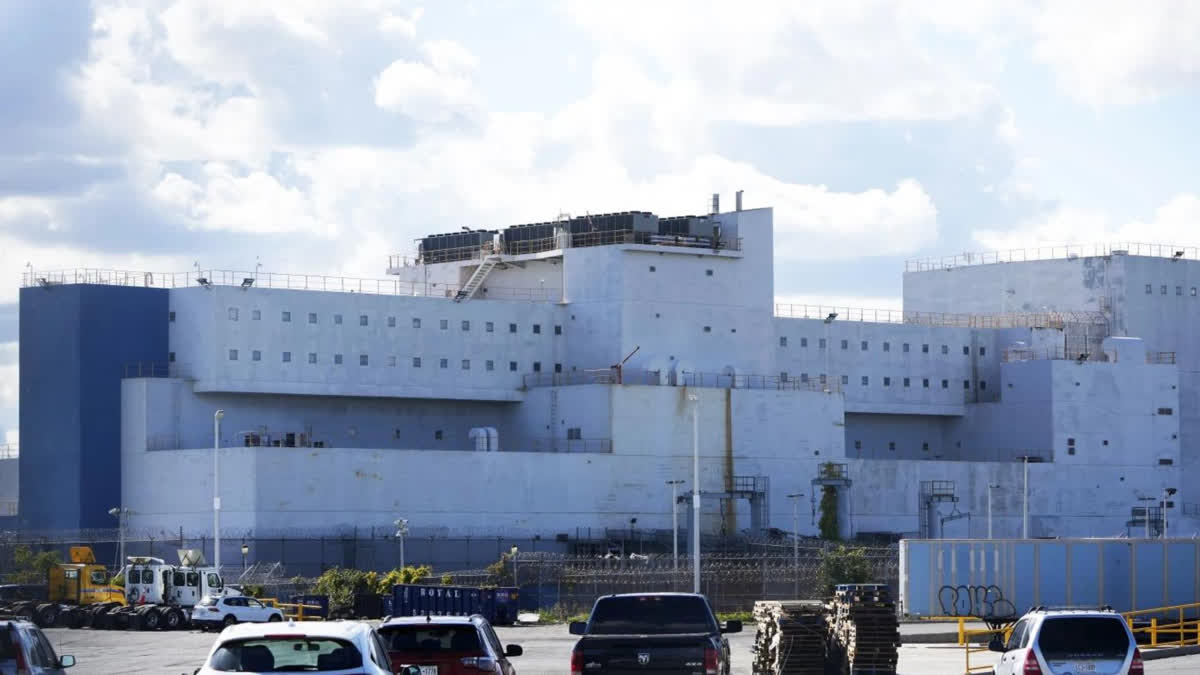New York : Kenneth Williams spent his whole life in Brooklyn, but it wasn't until a night in 2018 when he crossed a narrow footbridge in shackles, that he learned about New York City's last floating jail. He remembers the murky East River water below him, the stench of mold, and a sinking feeling that soon turned literal.
Every once in a while you could feel the boat dropping into the muck, Williams, 62, said. It was a stark reminder that this place wasn't meant for human confinement. Docked in the shallows off an industrial edge of the South Bronx, the Vernon C. Bain Correctional Center is a five-story jail barge that stretches the length of two football fields, resembling a container ship stacked with cargo.
It arrived in 1992 as a temporary measure to ease overcrowding on Rikers Island, the city's main jail complex for detainees awaiting trial. Three decades later, the 800-bed lockup the last operating prison ship in the United States is finally closing down. The ship will be fully vacated by the end of this week, officials said, as part of a broader plan to replace the city's long-troubled correctional system with a network of smaller jails.
For now, most of the roughly 500 people incarcerated on the ship will be transferred to Rikers Island, according to the Department of Correction, though the jails there are eventually supposed to close down, too. Detainees and advocates have long regarded the boat as a grim vestige of mass incarceration, an enduring symbol of the city's failures to reform dangerous jails that exist on the periphery of New York, largely out of sight of most residents and tourists.
In recent years, the unusual nautical jail has drawn attention primarily for its failures: Last September, a 44-year-old man, Gregory Acevedo, jumped from the top of the ship to his death; The year before that, Stephan Khadu, 24, died after contracting a form of treatable meningitis while in custody.
Darren Mack, co-director of the advocacy group Freedom Agenda, described the boat as a modern day slave ship used by the department to warehouse detainees, mostly Black and Latino men, with minimal oversight. While noting the closure was long overdue, he added, shifting people to the same hellish conditions on Rikers is not the answer.
Also Read : Google CEO defends paying Apple, other tech firms to make Google default search engine on devices
The last of an armada of floating jails used by New York City in the late 1980s and early 1990s, the Vernon C. Bain sits across the river from Rikers Island, between a wastewater treatment plant and a wholesale fish market. Detainees are afforded a daily hour of recreation on a caged upper deck, where they were recently seen playing basketball on a sunny morning. Otherwise, their only natural light beams through the ship's tiny portholes.
Those who've spent time on board say the boat rocks in the river's current. Its fading blue and white exterior a far cry from the freshly-painted surfaces visible in the 1993 film Carlito's Way is known to leak in the rain, occasionally short-circuiting the electrical system. Inside, rust cracks of the walls and detainees say they are packed into dormitories that grow suffocatingly hot in the summer, with cots that sit just a few inches from each other. If you faced the person in the bed next to you, your knees would touch, said Williams, who was incarcerated there for a few months and has since been released. If they snored, you could smell their breath.
The use of maritime jails in the United States has long been controversial, dating back to the earliest days of the Revolutionary War, when thousands of Americans died aboard British ships parked in the New York Harbor. Since then, the concept has been put to use sparingly during the gold rush in California, most notably often drawing allegations of cruelty and neglect, according to a recent study.
In the 1960s, a proposal by New York's correction commissioner to house inmates on repurposed ships was sunk by other local officials, who said the boats would give visitors the wrong image of the city. That sentiment began to change in the late 1980s and early 1990s, as drug arrests during the crack epidemic brought the population of Rikers Island to historic highs.
By the time the Vernon C. Bain boat arrived in the South Bronx, the city had already deployed four other floating jails including two converted city ferries and a former trooper ship with the dissonant nickname, the Love Boat as low-cost, temporary facilities. Mayor Edward Koch, an early champion of the idea, assured reporters that seasick inmates would be given Dramamine and dismissed questions about the boats' viability by calling it better accommodations than Rikers Island.
Also Read : Israel-Palestine war, day 23: Besieged people break into UN warehouses as death toll tops 8,000 in Gaza
Decades later, Stephan Khadu may have reached a similar conclusion as he awaited trial at Rikers Island for a gang conspiracy case. With the city's main jail complex gripped by both the coronavirus pandemic and rising violence in May 2020, Khadu volunteered to transfer to the Vernon C. Bain, where he waited nearly two years for a trial that never came.
By the following summer, family members said, Khadu talked about the boat's stifling heat, and the presence of mold and rodents that chewed through his food containers. He suffered a seizure in July 2021. Two months later, he had a second seizure. He died on the way to the hospital, a few days short of his 24th birthday.
The cause of death was later revealed to be a complication of lymphocytic meningitis, a rodent-borne viral disease that, if properly treated, is not typically fatal. His mom, Lezandre Khadu, blames the boat's disgusting conditions." How can they expect me to believe they care about these people when they treat them like cargo? she said. No human should have to live in this place.
The New York State Attorney General investigated Stephan Khadu's death, but said they could not confirm allegations of improper care. He had been awaiting trial for nearly 2 years. When the boat empties out, it won't be the first time. It also closed in the mid-1990s, as the population of Rikers Island began to fall. But unlike the other shuttered floating jails, the Vernon C. Bain reopened initially as a juvenile justice center under Mayor Rudy Giuliani, and later transitioning into a standard adult jail.
A spokesperson for the Department of Correction, Latima Johnson, declined to say what the city plans to do with the boat going forward. It will remain, for now, within the custody of the Department of Correction. The reason for this move is to centralize operations on the island to more efficiently manage people in custody and deploy staff and resources, Johnson said in an email.
Once the move is complete, Lezandre Khadu is planning a trip to see the boat where her son spent the final year of his life. She intends to celebrate its long-delayed closure. I'm walking over that bridge with a bucket of mimosas and I'm going to have the biggest party ever, she said. I want to see for myself that there will never be another soul on that boat.



